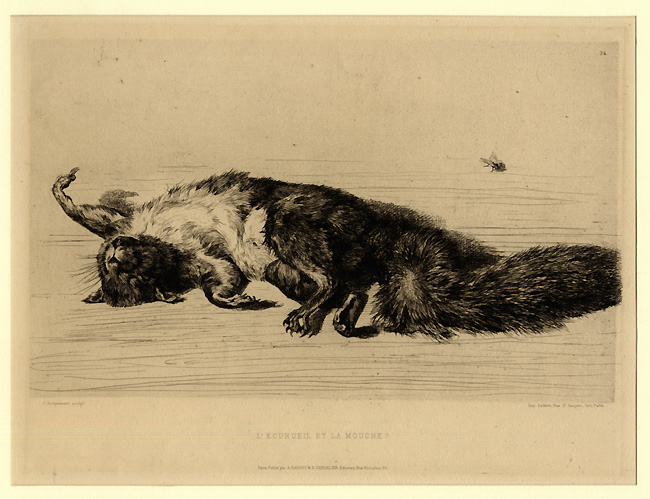Bizarre
- Lepic, Ce qui Restait du Puissant Guillaume de Naillac
- Claeaz, Dancers with Death
- Anonymous American, A Naked Man and Horse
- Klinger, Amor, Tod und Jenseits (Love, Death and the Hereafter)
- Surugue, La Folie pare la Décrépitude
- Legros, La Légende du Bonhomme Misère : La Mort dans le Poirier
- Rops, L’Enlèvement
- Sadeler, Allegory of Opulence, Fornication and Stupidity
- Mohlitz, La Vierge aux Étrons (The Virgin of Turds)
- Legrand, Épaves de Famille (Oddballs of the Family)
- Jacquemart, L’Écurueil (sic)
- Benassit, L’Absinthe!
- de Bry, Punishment of the Mutinous Indians
- Goncourt, Le Singe au Miroir (The Monkey at the Mirror)
- Callot, Les Martyrs du Japon
- Dillon, Les Mendiants (The Beggars)
- Barberis, The Witch
- Budzinski, The Thirsty Giant
- Meryon, Le Ministère de la Marine
- Torre-Bueno, Death’s Arrival
- van Meurs, Animals of America
- Redon, Félinerie
- Chagall, Le Vixe
- Martin, Indécision (Tête de Femme)
- Rops, Le Calvaire
- Rops, Les Frères de la Bonne Trogne
- Gillray, Tentanda via est qua ve quoque possim Tollere humo
- Underwood, Simian Ecstasy
- Veber, Beheaded!
- Strang, Death and the Ploughman’s Wife: Frontispiece
- Corman, The Temptation of Saint Anthony
- Bliss, Gargoyles Spouting
- Castellón, Of Land and Sea
- Eichenberg, Isaiah 11
- Rops, L’Idole (The Idol)
- Master MZ, Aristotle and Phyllis
- Bracquemond, “Hors de mon soleil, canailles!"
- Spare, Nemesis
- Higgens, Forgotten
- Anonymous, Jewish Amulet to Protect Mother and Child
- Daumier, Une Expérience Qui Réussit Trop Bien
- Seligmann, Le Roi du Charbon (King Charcoal)
- Braun, The Release of Force
- Callot, Le Grand Rocher
- Forest, Bâstard Foetus Hérédité, Comte D’Averton Mort-Né
- Jacque, La Souricière
- Veber, “Ah! Qu’il fait chaud"
- Pastelot, Les Sorcières
- Lepic, Le Verger du Roi Louis (The Orchard of King Louis)
- Grandville, Résurrection de la Censure
- Tidemann, The Earth Swallows Up the People of Korah
- Shields, The Descent
- Redon, C’est le diable
- Sadeler, Ita Erit et Aventus Filii Hominis
| 11. Jules Jacquemart (1837-1880) L’Écurueil et la Mouche? (The Squirrel and the Fly ?) |
(click on image to print)

L’Écurueil et la Mouche? (The Squirrel and the Fly ?)
Etching, 1862, 235 x 313 mm., Béraldi 330, Bailly-Herzberg (1863) 34, Gonse 330 iv/iv. Fine impression on Montgolfier laid paper with full, very large margins and with the blind stamp of Cadart & Chevalier; the paper lightly toned.
Jacquemart’s name is so associated with masterly etchings of porcelain, glass and other decorative objects that it is a bit of a surprise to find original images from him, particularly so when several of them are rather weird. Not too many artists would have found artistic satisfaction in etching a dead squirrel (fly or no fly), though the print is obviously reminiscent of several of Bracquemond’s. Is it another form of a Vanitas? Or was he simply interested in delineating the textures and colors of the fur and a dead squirrel gave a far better opportunity than a live one? But then, why the fly? The ultimate question is: what is the significance of the question mark at the end of the title? Or is that a contribution of the typesetter – who didn’t know how to spell L’Écureuil? An interesting oddity and, as expected, supremely well etched.
| $400.00 |